|
The "Bison Fire" was at its time the largest single wildfire to occur in Nevada. (There have been larger "complexes" when multiple fires burned together in the northeastern part of the state.)
The Bison Fire was started by lightning and grew to nearly 25,000 acres before it was contained.
Location
Smith Valley, in southern Lyon County.
Date and Time
Call received on July 9th around 4:30 PM.
Incident Details
Strong winds are pushing the fire toward the rural community of Smith Valley (population, approx. 1,600.) Most of the community consists of ranchettes with various species of pets and livestock. The fire has just passed the "trigger point" for which an evacuation of the community will take effect.
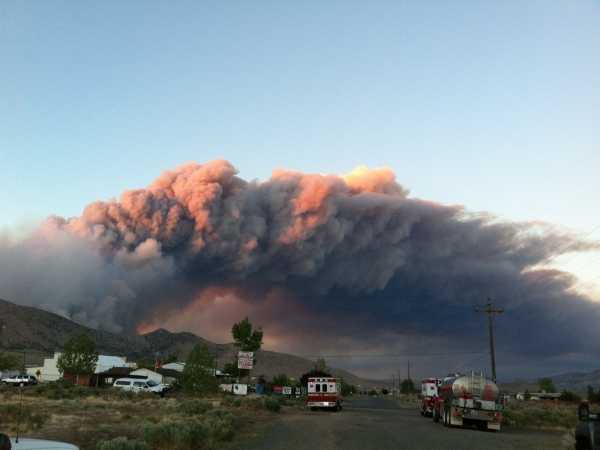
You have received a call to organize and command an Animal Rescue Group and report to the Search and Rescue Command Post at the fire's spike camp at Smith Valley High School.
You have available four in-county trained large animal crews with stock trailers, a crew from Douglas county with stock trailer and a team with a straight load trailer with the divider removed. (The Douglas County crew actually has faster access to the command post than the in-county crews.)
Also available to you is a cache of animal crates of various sizes.
(Please feel free to substitute these resources with those that may generally be available to you in your own location when submitting solution ideas.)
Your objective is to organize the rescue in the context of a major wildfire that is operating under a unified joint command structure, using your own mobile and personnel resources with possible assistance of a Search and Rescue team member to aid in street identification and determine safe routes.
This very real scenario is a good test of organizational, planning, organization of resources and coordination skills.
Skull Session Questions
- What are your priorities?
- What are the safety issues?
- What resources do you need?
- Describe your action plan.
Group Feedback.
Ideas posted by the group included:
- Report to SAR Command Post for a situational briefing
- Identify, establish and secure practical shelter facilities.
- Forward the sheltering information to the incident PIO for media releases.
- Send evaluation team to assess the situation and options.
- Continue to assess and plan.
- Facilitate owners taking care of their own animals if possible.
- Use written communications and use signs where needed to instruct the public.
- Get shelter team in place.
- Locate indoor facility for delicate small animals such as birds that need a regulated environment.
- Identify an alternative sheltering facility in the event the primary facility becomes compromised or fills up.
- Develop logistic strategies for obtaining necessary feed and supplies.
- Plan for how to deal with unexpected arrivals of volunteers and resources.
- Have a plan for dealing with waste if animals are sheltered for any length of time.
- Maintain communications between the rescue group and SAR CP.
This was a large and dangerous fire.
View from the far end of the range on the opposite side of the county.
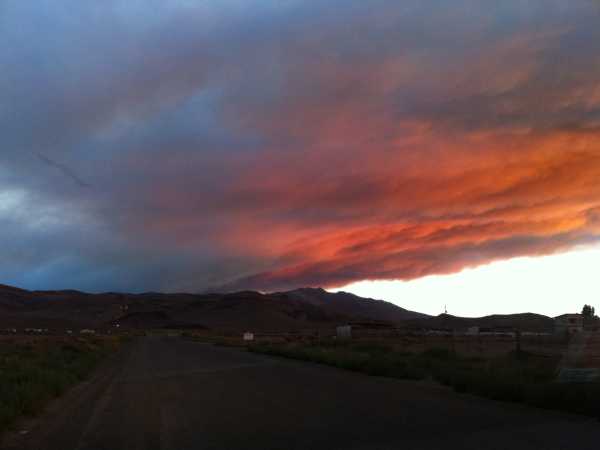
Mid afternoon looked like twilight.
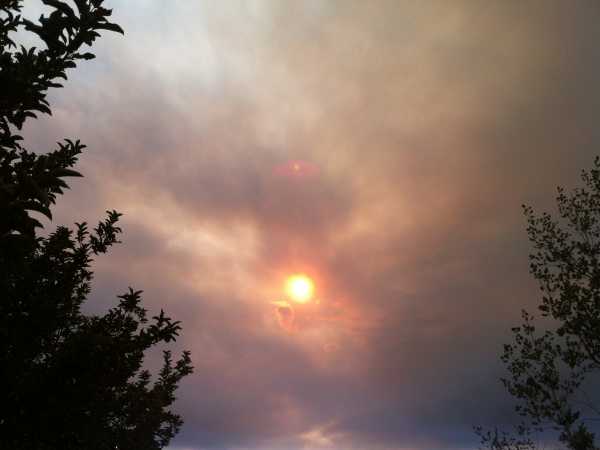
This lightning caused fire had been burning since July 4th, so there was sufficient time for contingency planning and community awareness.
The Sheriff's substation had a good relationship with the community so the residents were kept well informed.
Several of the SAR members had taken TLAER training so they organized many of the citizen self-help activities.
The animal team was placed on an advisory stand-by when it looked as if the fire might overtake the evacuation trigger point. That advisory helped reduce reflex times as teams could prepare in advance.
The formal call-out came about 4:30 PM as the afternoon winds were picking up. Details and acknowledgments had to be transmitted via text as cellular voice service was intermittent.
The county is fairly large and has numerous mountain ranges. A response from the central county to Smith Valley took well over an hour. SAR managed animal issues while the team was enroute.
View enroute to Smith Valley. (This was an otherwise cloudless day.)
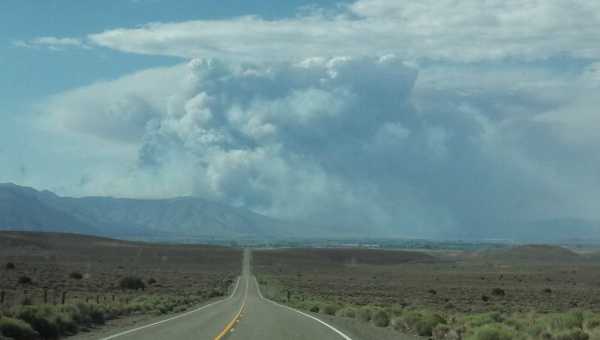
The Animal Rescue Group consisted of a strike team of five stock trailers pulled by 4-wheel drive pickups and a small animal single resource that consisted of a 2-horse trailer filled with portable animal crates.
(Strike teams usually consist of five similar resources. We only had four certified stock trailers in service at the time in the county so a trailer was requested from Douglas county to fill out the team.)
Everyone reported to the staging area at Smith Valley High School.
The Animal Rescue Group Supervisor obtained a briefing at the SAR Command Post.
Primary and secondary shelter locations were identified. Distribution of animals would depend largely on wind direction and fire behavior.
SAR indicated that they had completed surveys of the most immediately threatened properties and they confirmed that residents had already relocated pets and livestock. Because of this early action on the part of Sheriff's deputies and SAR volunteers, the most urgent animal issues were resolved while we were still enroute.
As a result of these earlier actions, our primary concerns focused on the fire's behavior once it entered town, and assisting in removals of animals in areas that would then be threatened, especially given that these evacuations would likely have to be undertaken after dark.
We held the small animal unit at staging, but during that time plans were made for small animals with the emergency shelter that was set up at a local church. The small animal unit would deploy as soon as the fire actually reached the town.
Streets were plotted and the intended strategy for the large animal strike team was to work as a team, starting with the most at-risk animals and working toward the emergency shelter location. Having additional personnel would better facilitate setting up of loading chutes and handling animals, and would make the drop-offs more orderly.
The team concept would not preclude a single resource responding with a SAR escort if circumstances warranted.
We had about 30 minutes before the fire would reach the boundary properties, so we checked our gear and rested.
Crews resting at staging.
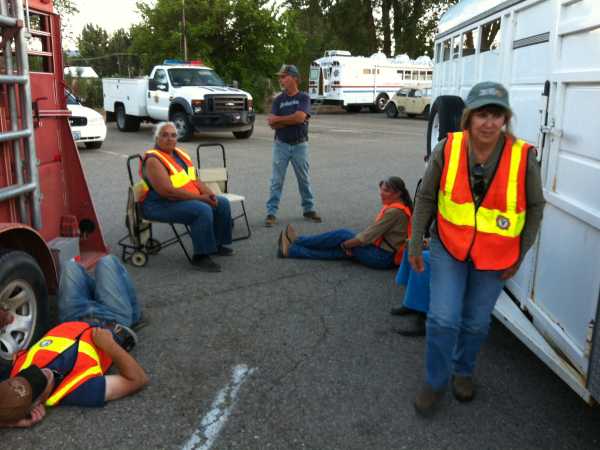
At that point a truly amazing event happened. Just as the fire was reaching the base of the mountain range, the wind died down for a few minutes, the convected heat from the fire caused a draft back towards the fire, air and ground crews took immediate advantage just as reinforcements from other counties were arriving. The east flank of the largest fire in Nevada, one that had burned uncontrolled for five days, was knocked down in about 45 minutes.
An amazing stop by air and ground resources.
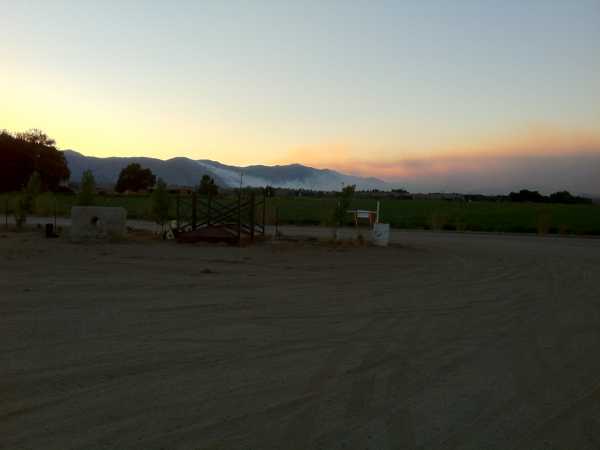
We were held for a couple of hours in case the winds got sufficiently strong to jump the fire line. The line did hold and we were subsequently released.
| 




